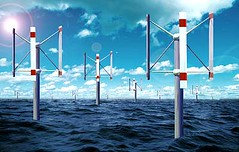Everyone Knows It's Windy
Reading through the Economist's Technology Quarterly last night and I came across this very interesting take on wind turbines:
TMA, a company based in Cheyenne, Wyoming, announced in November that its first vertical-axis wind turbine (VAWT) would soon be ready for commercial production. The TMA system has two sets of vertical blades. The two inner blades, each shaped like a half-cylinder, catch the wind and rotate about a central axis, while the three outer blades, shaped like aircraft wings, are fixed. The interaction between the two sets of blades causes a drop in pressure in front of the rotating blades' leading edges, which further increases the rate of rotation. TMA claims that its system harvests 43-45% of the wind's available energy; conventional propeller-style turbines, in contrast, have efficiencies of 25-40%.
In winds of more than 80kph (50mph), furthermore, the blades and gearboxes of conventional turbines cannot cope with the strain, and they have to be shut down. TMA says its vertical-axis design can still work even at wind speeds as high as 110kph, however.
Another benefit is that VAWTs can be assembled from smaller pieces on site, whereas conventional have to be made and transported in one piece (did not know that). But these might not be the end-all/be-all solution:
Neither TMA nor Eurowind has yet proved the technology in commercial deployments, however, and the mainstream wind industry remains sceptical about the benefits of VAWTs, in large part because the idea is not new. [...] Even large-scale VAWTs have been tried before. In the early 1990s the British government funded a trial in Carmarthen Bay in Wales, which culminated in the construction of a 500 kilowatt, 35-metre turbine. But it failed after six months because of a manufacturing fault, and the trial was wound up shortly afterwards. The project's final report concluded that VAWTs had no applications on land, but they should be reconsidered “if offshore wind energy becomes more attractive”.
[...]
With plans afoot to build wind farms off the coast of Britain and elsewhere, the fortunes of the VAWT may be about to take a turn for the better.



0 Comments:
Post a Comment
<< Home